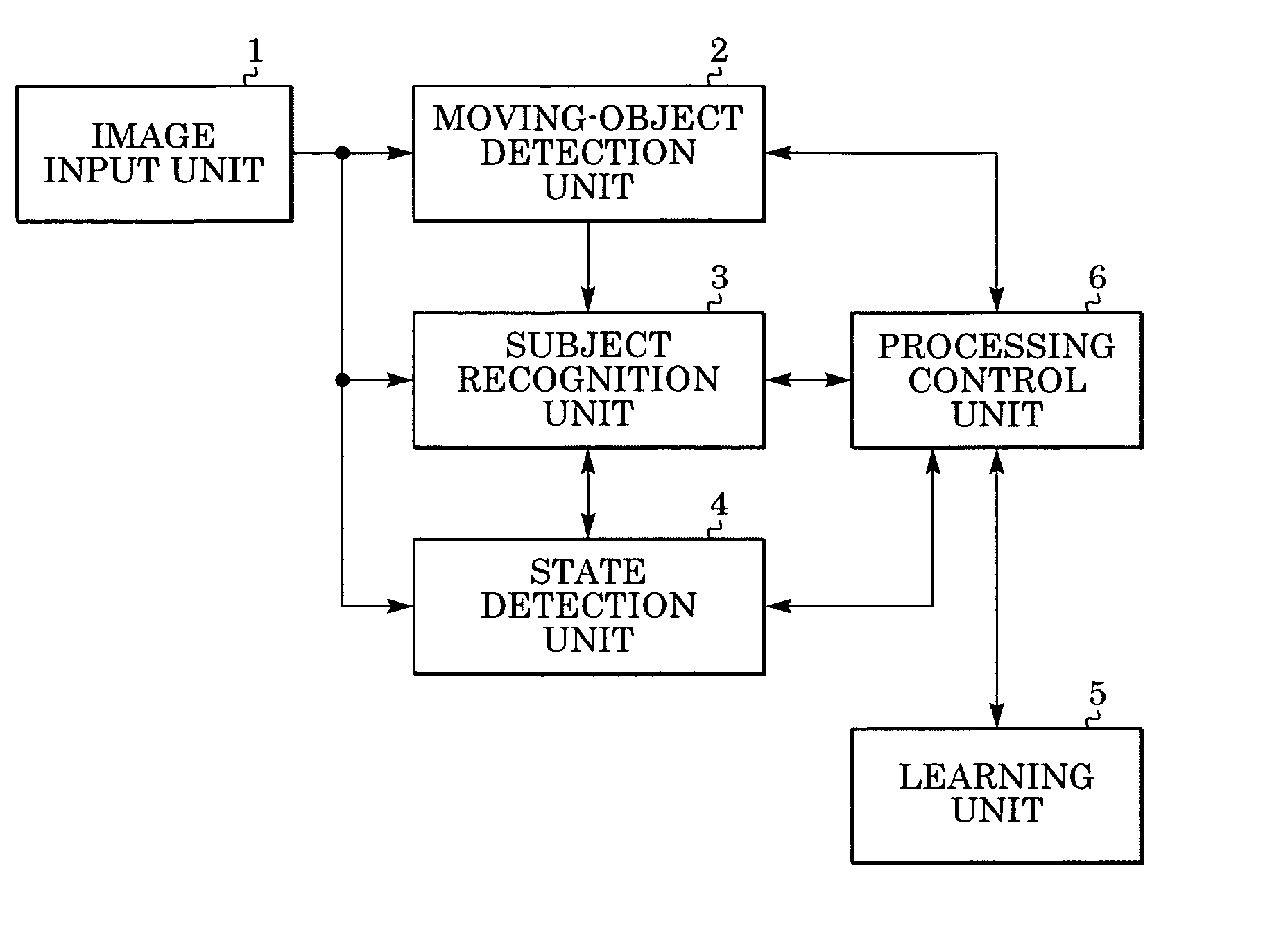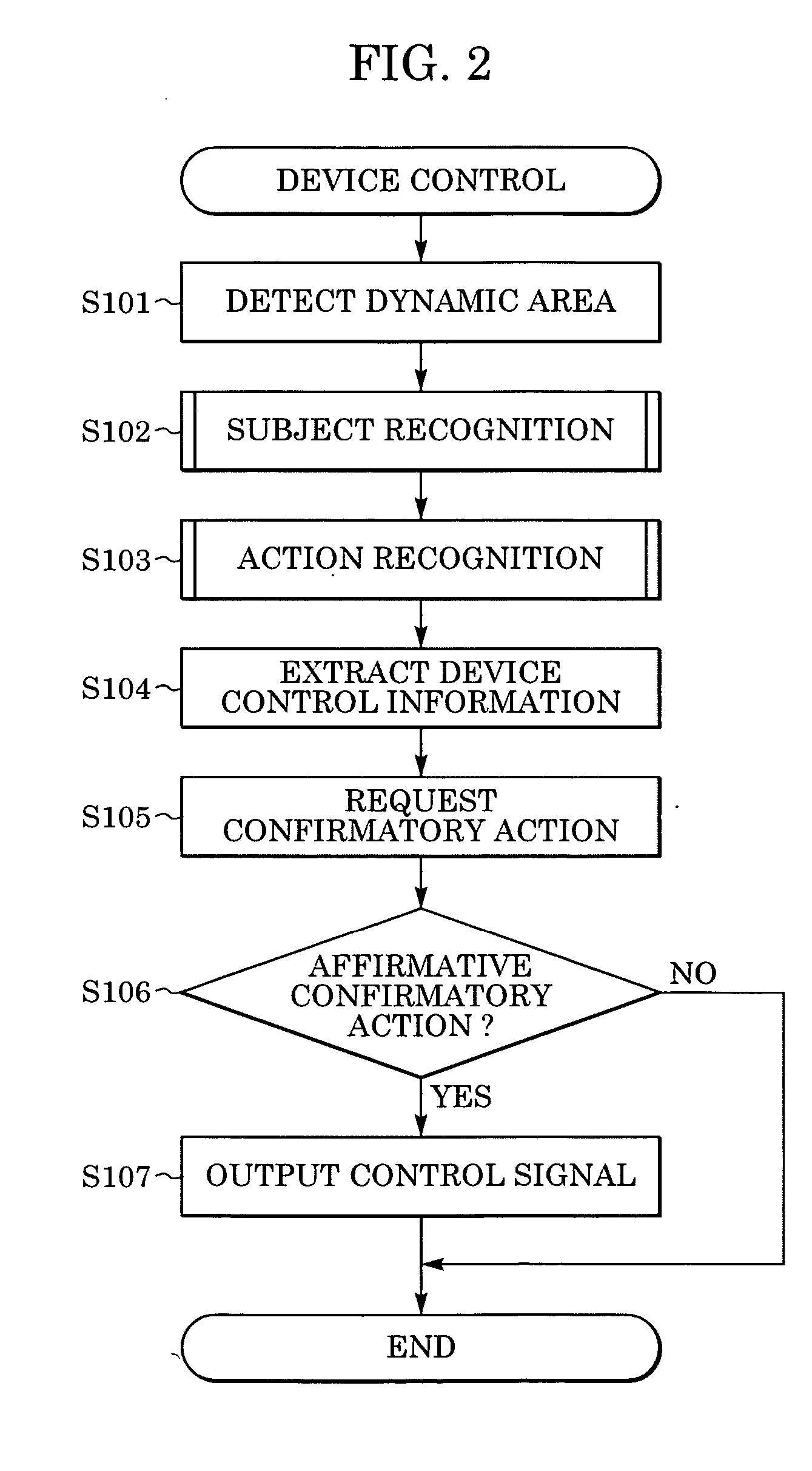Action recognition apparatus and method, moving-object recognition apparatus and method, device control apparatus and method, and program
a technology of moving objects and recognition apparatus, applied in the direction of instruments, printers, cameras focusing arrangements, etc., can solve the problems of difficult to distinguish persons having similar walking patterns from each other, difficult to automatically personalize a working environment, and inability to recognize moving objects such as subjects
- Summary
- Abstract
- Description
- Claims
- Application Information
AI Technical Summary
Benefits of technology
Problems solved by technology
Method used
Image
Examples
first embodiment
[0034]FIG. 1 is a schematic diagram of an action recognition apparatus according to the present invention.
[0035] Referring to FIG. 1, the action recognition apparatus includes an image input unit 1 for inputting moving image data from an imaging unit or a database (not shown); a moving-object detection unit 2 for detecting and outputting a dynamic (moving) area based on motion vectors and other features of the input moving image data; a subject recognition unit 3 for recognizing a subject, such as a person or an object, located in the detected dynamic area and outputting the recognition result; a state detection unit 4 for detecting an action and a state of a person serving as the subject recognized by the subject recognition unit 3; a learning unit 5 for learning person-specific meaning of the action or state detected by the state detection unit 4 and for storing the meaning in predetermined storage means; and a processing control unit 6 for controlling the startup and stop of proc...
second embodiment
[0079]FIG. 5 is a schematic diagram depicting an action recognition apparatus according to the present invention.
[0080] The action recognition apparatus in FIG. 5 is the same as that in FIG. 1, except that the learning unit 5 has the structure shown in FIG. 6 and that the apparatus in FIG. 5 additionally includes an object-for-daily-use detection unit 7 for detecting and registering objects-for-daily-use. As shown, the object-for-daily-use detection unit 7 is connected to the state detection unit 4 and the learning unit 5. The term object-for-daily-use refers to objects such as tools, devices, and apparatuses that are frequently used by the person serving as a subject. Examples of such objects are coffee cups, bedclothes, toothbrushes, and books.
[0081] The action recognition apparatus according to the present embodiment can be incorporated in a state monitoring system (including two or more cameras and one or more action recognition apparatuses according to the present embodiment) ...
third embodiment
[0095]FIG. 9 is a schematic diagram showing an action recognition apparatus according to the present invention.
[0096] The action recognition apparatus in FIG. 9 is the same as that in FIG. 5, except that the apparatus in FIG. 9 additionally includes a gazed-object detection unit 9 for performing gazed-object-category extraction processing in FIGS. 12A and 12B and a habitual behavior determination unit 10 for detecting and learning habitual behavior of a subject person using time-series image data from a predetermined observation position. As shown, the habitual behavior determination unit 10 is connected to the state detection unit 4.
[0097] The term “habitual behavior” refers to such behavior performed relatively frequently by a particular subject person that is associated with at least one of a place and a time slot. With the learning and detection of such habitual behavior, person authentication and automatic device / environmental setting appropriate for habitual behavior patterns...
PUM
 Login to View More
Login to View More Abstract
Description
Claims
Application Information
 Login to View More
Login to View More - R&D
- Intellectual Property
- Life Sciences
- Materials
- Tech Scout
- Unparalleled Data Quality
- Higher Quality Content
- 60% Fewer Hallucinations
Browse by: Latest US Patents, China's latest patents, Technical Efficacy Thesaurus, Application Domain, Technology Topic, Popular Technical Reports.
© 2025 PatSnap. All rights reserved.Legal|Privacy policy|Modern Slavery Act Transparency Statement|Sitemap|About US| Contact US: help@patsnap.com



